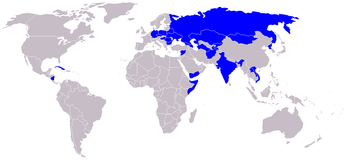
The Warsaw Pact (WP), formally the Treaty of Friendship, Cooperation and Mutual Assistance (TFCMA), was a collective defense treaty signed in Warsaw, Poland, between the Soviet Union and seven other Eastern Bloc socialist republics of Central and Eastern Europe in May 1955, during the Cold War. The term "Warsaw Pact" commonly refers to both the treaty itself and its resultant defensive alliance, the Warsaw Treaty Organization (WTO). The Warsaw Pact was the military and economic complement to the Council for Mutual Economic Assistance (Comecon), the regional economic organization for the Eastern Bloc states of Central and Eastern Europe.
A satellite state or dependent state is a country that is formally independent but under heavy political, economic, and military influence or control from another country. The term was coined by analogy to planetary objects orbiting a larger object, such as smaller moons revolving around larger planets, and is used mainly to refer to Central and Eastern European member states of the Warsaw Pact during the Cold War, as well as to Mongolia and Tuva between 1924 and 1990, all of which were economically, culturally, and politically dominated by the Soviet Union. While primarily referring to the Soviet-controlled states in the Central and Eastern Europe or Asia, in some contexts the term also refers to other countries under Soviet hegemony during the Cold War, such as North Korea, Cuba, and some countries in the American sphere of influence, such as South Vietnam. In Western usage, the term has seldom been applied to states other than those in the Soviet orbit. In Soviet usage, the term applied to states in the orbit of Nazi Germany, Fascist Italy, and Imperial Japan, whereas in the West the term to refer to those has typically been client states.

A communications satellite is an artificial satellite that relays and amplifies radio telecommunication signals via a transponder; it creates a communication channel between a source transmitter and a receiver at different locations on Earth. Communications satellites are used for television, telephone, radio, internet, and military applications. Many communications satellites are in geostationary orbit 22,236 miles (35,785 km) above the equator, so that the satellite appears stationary at the same point in the sky; therefore the satellite dish antennas of ground stations can be aimed permanently at that spot and do not have to move to track the satellite. Others form satellite constellations in low Earth orbit, where antennas on the ground have to follow the position of the satellites and switch between satellites frequently.

An emergency position-indicating radiobeacon (EPIRB) is a type of emergency locator beacon for commercial and recreational boats, a portable, battery-powered radio transmitter used in emergencies to locate boaters in distress and in need of immediate rescue. In the event of an emergency, such as a ship sinking or medical emergency onboard, the transmitter is activated and begins transmitting a continuous 406 MHz distress radio signal, which is used by search-and-rescue teams to quickly locate the emergency and render aid. The signal is detected by satellites operated by an international consortium of rescue services, COSPAS-SARSAT, which can detect emergency beacons anywhere on Earth transmitting on the distress frequency of 406 MHz. The satellites calculate the position or utilize the GPS coordinates of the beacon and quickly passes the information to the appropriate local first responder organization, which performs the search and rescue. As Search and Rescue approach the search areas, they use Direction Finding (DF) equipment to locate the beacon using the 121.5 MHz homing signal, or in newer EPIRBs, the AIS location signal. The basic purpose of this system is to help rescuers find survivors within the so-called "golden day" during which the majority of survivors can usually be saved. The feature distinguishing a modern EPIRB, often called GPIRB, from other types of emergency beacon is that it contains a GPS receiver and broadcasts its position, usually accurate within 100 m (330 ft), to facilitate location. Previous emergency beacons without a GPS can only be localized to within 2 km (1.2 mi) by the COSPAS satellites and relied heavily upon the 121.5 MHz homing signal to pin-point the beacons location as they arrived on scene.
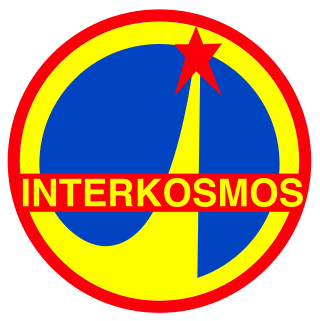
Interkosmos was a Soviet space program, designed to help the Soviet Union's allies with crewed and uncrewed space missions.
The Global Maritime Distress and Safety System (GMDSS) is a worldwide system for automated emergency signal communication for ships at sea developed by the United Nations' International Maritime Organization (IMO) as part of the SOLAS Convention.
AMSAT is a name for various amateur radio satellite organizations worldwide. In particular, it often refers to the Radio Amateur Satellite Corporation, headquartered in Washington, D.C. AMSAT organizations design, build, arrange launches for, and then operate (command) satellites carrying amateur radio payloads, including the OSCAR series of satellites. Other informally affiliated national organizations exist, such as AMSAT Germany (AMSAT-DL) and AMSAT Japan (JAMSAT).
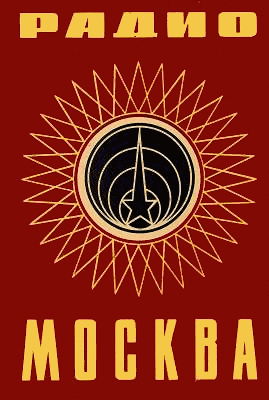
Radio Moscow, also known as Radio Moscow World Service, was the official international broadcasting station of the Union of Soviet Socialist Republics until 1993, when it was reorganized into Voice of Russia, which was subsequently reorganized and renamed into Radio Sputnik in 2014. At its peak, Radio Moscow broadcast in over 70 languages using transmitters in the Soviet Union, Eastern Europe, and Cuba.

The Ilyushin Il-14 was a Soviet twin-engine commercial and military personnel and cargo transport aircraft that first flew in 1950, and entered service in 1954. The Il-14 was also manufactured in East Germany by VEB Flugzeugwerke as the VEB 14 and in Czechoslovakia as the Avia 14. The Ilyushin Il-14 was typically replaced by the Antonov An-24 and Yakovlev Yak-40.
Radio jamming is the deliberate blocking of or interference with wireless communications. In some cases, jammers work by the transmission of radio signals that disrupt telecommunications by decreasing the signal-to-noise ratio.
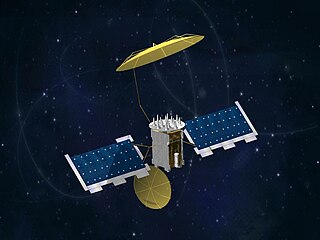
The Mobile User Objective System (MUOS) is a United States Space Force narrowband military communications satellite system that supports a worldwide, multi-service population of users in the ultra high frequency (UHF) band. The system provides increased communications capabilities to newer, smaller terminals while still supporting interoperability with legacy terminals. MUOS is designed to support users who require greater mobility, higher bit rates and improved operational availability. The MUOS was declared fully operational for use in 2019.

Telecommunications engineering is a subfield of electronics engineering which seeks to design and devise systems of communication at a distance. The work ranges from basic circuit design to strategic mass developments. A telecommunication engineer is responsible for designing and overseeing the installation of telecommunications equipment and facilities, such as complex electronic switching systems, and other plain old telephone service facilities, optical fiber cabling, IP networks, and microwave transmission systems. Telecommunications engineering also overlaps with broadcast engineering.

Radio is the technology of communicating using radio waves. Radio waves are electromagnetic waves of frequency between 3 hertz (Hz) and 300 gigahertz (GHz). They are generated by an electronic device called a transmitter connected to an antenna which radiates the waves. They are received by another antenna connected to a radio receiver. In addition to communication, radio is used for radar, radio navigation, remote control, remote sensing, and other applications.
Television is the most popular medium in Russia, with 74% of the population watching national television channels routinely and 59% routinely watching regional channels. There are 6,700 television channels in total. Before going digital television, 3 channels have a nationwide outreach : Channel One, Russia-1 and NTV.
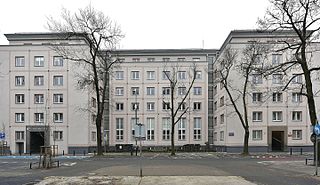
The Organization for Cooperation of Railways, was established as the equivalent of the International Union of Railways (UIC) to create and improve the coordination of international rail transport. Concerning especially the transports between Europe and Asia, it has helped develop cooperation between railway companies and with other international organisations. The members of this organisation created an international transport law.
JCSAT-110, also known as N-SAT 110, JCSAT-7, Superbird-5 and Superbird-D, is a Japanese geostationary communications satellite which was operated by JSAT Corporation and Space Communications Corporation until both companies merged into SKY Perfect JSAT Group in 2008. It is positioned in geostationary orbit at a longitude of 110° East, from where it is used to provide communications services to Japan.
An amateur radio satellite is an artificial satellite built and used by amateur radio operators. It forms part of the Amateur-satellite service. These satellites use amateur radio frequency allocations to facilitate communication between amateur radio stations.

Federal State Unitary Enterprise Satellite Communications or Russian Satellite Communications Company is the main state operator of communications satellites. It is the Russian operator for the international satellite communications systems Intelsat, Eutelsat and Intersputnik, cooperating with these organizations and handling international account settlements.

OSCAR 1 is the first amateur radio satellite launched by Project OSCAR into low Earth orbit. OSCAR I was launched December 12, 1961, by a Thor-DM21 Agena B launcher from Vandenberg Air Force Base, Lompoc, California. The satellite, a rectangular box weighing 10 kg., was launched as a secondary payload (ballast) for Corona 9029, also known as Discoverer 36, the eighth and final launch of a KH-3 satellite.

